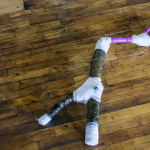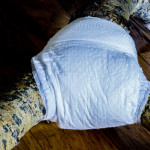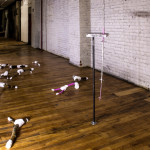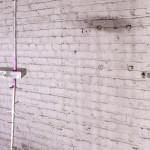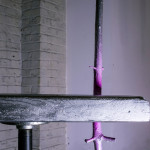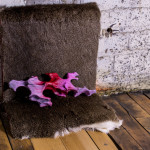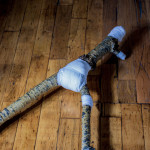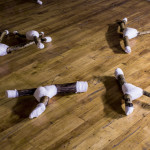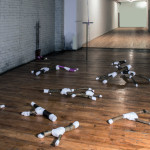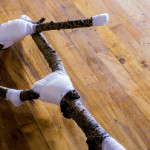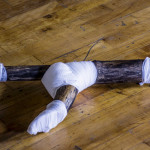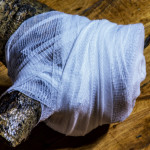LUMIR HLADIK – “BASTA!”, SEPTEMBER 21 – NOVEMBER 4, 2014
Elements and methods used: aspen branches, diapers, steel pipe, young pine trunks, wood, deer fur, tropical wood eroded by ocean water, acrylic paint and gauze.
BASTA! is the fourth installation piece of Lumir Hladik presented by corridor213, following the display of “The Great White” and “Pining in White”, BASTA! is the darkest of his VANITAS series. This installation consists mostly of “treated” natural elements collected in Ontario and Costa Rica. It contains three entities: Aspen tree branches dressed up with diapers and gauze, a floor-based shelve unit clad in deer fur that carries an amorphous bone/meat like object and an elevated, chromed wooden platform that serves as a base for two chromed thin pine trunks – one growing up and the other, almost as an mirror image or reflection, inverted. The base and tips of these young pine trunks are sprayed pink. We asked the artist if he recalls what may have triggered his latest display. Apparently, there were many influences, but one stuck. According to the generally accepted and agreed upon (written) rules of war, the main objective for a soldier is to “kill healthy male soldiers”… Does it make sense to provide dead Aspen branches with diapers? Does it make sense to give birth to and take care of healthy babies… in order to see them dead a few years later? The entire installation feels like a dystopian nightmare. We are entering a site where distance builds fear and ambiguity submissiveness, where a Fata Morgana castle levitates far above the silent, peaceful carnage… a monument or anti-monument… perhaps a symbol of unimpeded power and want, a place where rules and doctrines are written… daily, and signed with a swoosh and elation. A true Kafka’s castle, that impresses from afar and turns into mental vapor as we come, or better yet, “think” closer.
In his installation art, Lumir Hladik explores a new facet of the disrespect for death theme that inspires his work. His installations are referred to as a contemporary version of Vanitas, the symbolic art form originated in 16th century Holland. Hladik claims, “The lack of respect for death is killing life”.





